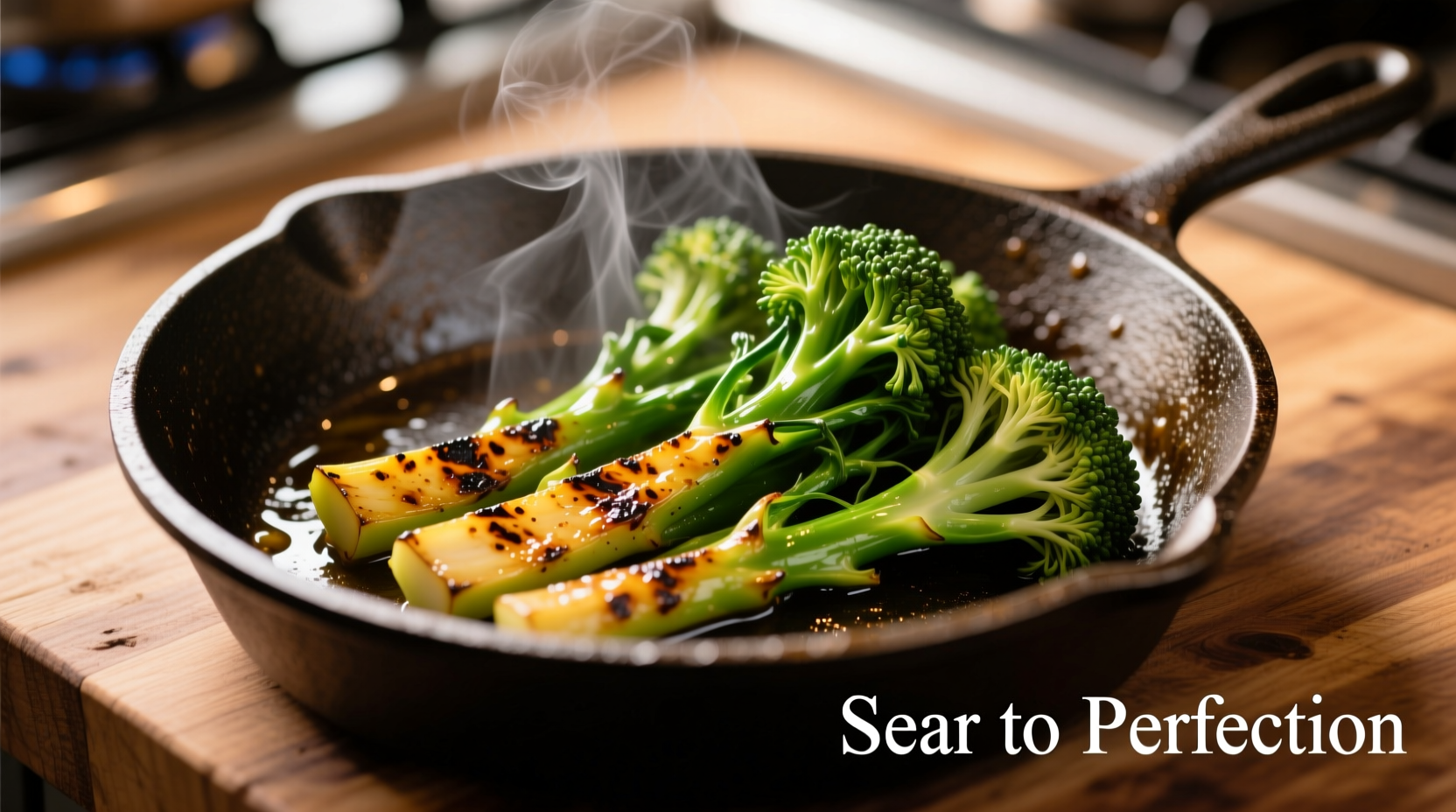Why Pan-Cooking Broccolini Beats Other Methods
While steaming preserves nutrients, pan-searing creates complex flavor through the Maillard reaction. Broccolini's delicate structure requires precise heat control - too low and it steams in its own moisture, too high and the slender stems burn before cooking through. This method delivers restaurant-quality results with minimal equipment.
What You'll Need for Perfect Pan Broccolini
| Category | Essential Items | Pro Tips |
|---|---|---|
| Vegetable | 1 bunch broccolini (12-14 oz) | Select stalks with tight florets and crisp stems |
| Cooking Fat | 1½ tbsp avocado oil | Higher smoke point than olive oil prevents bitterness |
| Flavor Enhancers | 2 garlic cloves, ½ lemon, ¼ tsp red pepper flakes | Microplane zest maximizes citrus impact |
| Equipment | 12-inch stainless steel skillet | Nonstick won't create proper sear marks |
The 4-Phase Cooking Process (Follow This Sequence)
Phase 1: Strategic Prep (90 Seconds)
Unlike broccoli, broccolini stems are entirely edible but require smart trimming. Don't cut florets - simply snap off the bottom 1-2 inches where stems naturally break. Rinse thoroughly in cold water, then crucially dry in a salad spinner. Water droplets cause steaming instead of searing. Arrange on kitchen towels while heating pan.
Phase 2: Heat Management (Critical First 2 Minutes)
Place skillet over medium-high heat for 1 minute until water droplets sizzle immediately. Add oil and swirl to coat. When oil shimmers (not smokes), arrange broccolini in single layer at 45-degree angle to maximize surface contact. Don't move for 90 seconds - this creates the foundational sear. Proper heat level produces audible sizzle without burning.

Phase 3: Precision Cooking (3-4 Minutes)
After initial sear, flip stalks using tongs. Add minced garlic and red pepper flakes. Cook 2 minutes while gently shaking pan every 30 seconds. At 4 minutes total, check tenderness: stems should bend slightly when lifted but not droop. For crisp-tender texture, remove from heat at 5-6 minutes - residual heat continues cooking. Overcooking causes mushy texture and yellowing.
| Cooking Stage | Visual Indicator | Texture Test |
|---|---|---|
| 2 minutes | Bottom third turns bright green | Firm resistance when pressed |
| 4 minutes | Color deepens throughout | Slight bend at midpoint |
| 6 minutes | Vibrant uniform green | Crisp-tender with slight snap |
Phase 4: Flavor Amplification (Final 60 Seconds)
Transfer to serving plate immediately. Squeeze ½ tablespoon lemon juice over top and rub zest directly onto hot vegetables - the heat releases essential oils for maximum flavor impact. Finish with flaky sea salt. Never add salt before cooking as it draws out moisture and prevents proper searing.
Avoid These 3 Common Mistakes
- Overcrowding the pan: Causes steaming instead of searing - cook in batches if needed
- Using cold ingredients: Room temperature garlic prevents burning, cold lemon juice dulls flavor development
- Adding liquid too early: Wait until final minute to incorporate any sauces
When Pan Cooking Isn't Ideal: Context Boundaries
This method shines for 1-2 servings with fresh broccolini. For larger batches (4+ servings), roasting at 425°F (220°C) for 15 minutes provides more consistent results according to USDA cooking research. If using slightly wilted broccolini, revive in ice water for 10 minutes before cooking to restore crispness.
Serving Suggestions That Elevate the Dish
Pair with protein-rich meals since broccolini contains 3g protein per cup (USDA FoodData Central). For Italian flair, toss with 1 tbsp grated Parmesan after cooking. Asian-inspired version: substitute sesame oil and finish with 1 tsp rice vinegar. The vegetable's natural sweetness complements grilled meats - particularly salmon or chicken.
Storage and Reheating Protocol
Store leftovers in airtight container for up to 3 days. To reheat without sogginess: place in preheated skillet over medium heat for 60-90 seconds, shaking pan frequently. Microwave reheating causes texture degradation - the high water content turns to steam, making stems limp.
Frequently Asked Questions
Can I use olive oil instead of avocado oil for cooking broccolini?
Yes, but use light refined olive oil (smoke point 468°F/242°C) rather than extra virgin (smoke point 375°F/190°C). Extra virgin olive oil will burn at the required medium-high heat, creating bitter compounds. For best results, keep extra virgin for finishing after cooking.
Why does my broccolini always turn out soggy when pan-cooked?
Sogginess occurs from three common errors: not drying vegetables thoroughly after washing, overcrowding the pan (causing steaming), or cooking on too low heat. Ensure broccolini is completely dry, use a large enough skillet for single-layer cooking, and maintain medium-high heat throughout the process.
How can I tell when broccolini is perfectly cooked?
Perfectly cooked broccolini should be vibrant green with slight charring at contact points. Stems should bend slightly when lifted with tongs but still offer resistance (crisp-tender texture). Overcooked broccolini turns olive green, droops when lifted, and separates easily at stem joints. The ideal window is narrow - check at 5 minutes for best results.
Can I add other vegetables to the pan with broccolini?
Yes, but add vegetables according to density. Start with harder vegetables like asparagus (cook 2 minutes first), then add broccolini. Softer vegetables like zucchini should be added in the final 2 minutes. For mixed vegetables, reduce heat to medium after initial sear to prevent broccolini from overcooking while denser vegetables finish.











 浙公网安备
33010002000092号
浙公网安备
33010002000092号 浙B2-20120091-4
浙B2-20120091-4